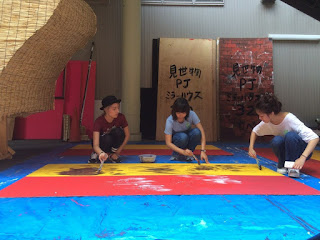Japanese school and Haunted houses!
At the start, I would like to mention that
this is my first blog post so I'm not too sure about the quality, but I’ll try
my best to convey my thoughts about one of my best experiences studying here at
KICL (Kyoto Institute of Culture and Language). I’m an Engineering graduate
from Egypt, and have been studying Japanese nonchalantly for about a year and a
half before coming to Japan. So, when I started studying at KICL I was enrolled
into beginner-intermediate level, which I felt like it was the perfect fit
for me.
# Projects
What I’m here for is to tell you about my
experience joining one of the many projects you can join during your study at
KICL. One of the great things about KICL is that the school is located in the
campus of a Japanese University which gives you a lot of chances to speak with
natives.
From within all the projects I decided to
join the Obakeyashiki (お化け屋敷) project. The
problem for me was that the only option was to join as a volunteer, and I guess
I wanted a more immersive experience so I asked if I can join as a member. To
my surprise the teacher responsible for the coordination between KICL and
KUAD’s project center (Kyoto University of Art and Design) was very helpful and
arranged it for me so I can join as a member.
# Meetings
If you are wondering what is an
"Obakeyashiki" (お化け屋敷)? It basically
means a "Haunted house", where お化け means ghost or monster, and 屋敷 means residence or house. In this project, we had to come up with a
story, decide the number of rooms and depending on the story, each room would
have a different theme to it.
# Production
After all the planning and brainstorming we
did (I couldn’t contribute much though!) it was finally the start of
production. At this point the volunteers from KICL were able to join and help
the teams that were lacking in members.
Near the end of finishing the Obakeyashiki
we started some trial runs to make sure that the ideas we came up with did work
as intended and make adjustments if needed.
If I’m being honest here it was really
tiring and the schedule was tight; we only took weekends and 4 days off during
the summer break. Even with that said it was extremely fun and I was able to
learn a bunch of new things. The KUAD’s project center staff were beyond
helpful and I was at no time feeling myself in a predicament. Moreover, the
Japanese students I was working with were very friendly and made my experience
even that more special.
# After the project
Also, all the practice I had in terms of listening
at least did work out! I already passed the JLPT N3 and N2 from the first try
without even studying for it. My Kanji and reading scores were horribly bad but
my listening was what helped me pass the tests. There are a lot more to say about
the project but I don’t want to drag it out too much! For example, we visited
an Obakeyashiki in Osaka for reference, we played with sparklers and some small
fireworks at some point, as well as going out eating on occasions. It’s been a
little over 4 months since the project has ended, but I’m still on good terms
with many of the friends I made there and go out every once in a while. It
really was a great experience and I encourage anyone who is interested to try
joining one of the projects here at KICL.



















0 件のコメント:
コメントを投稿